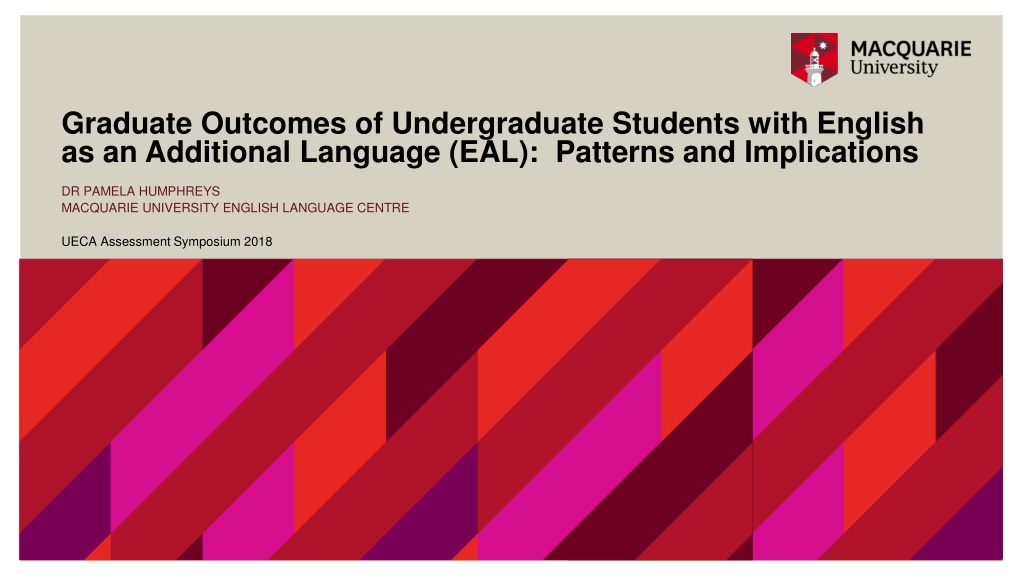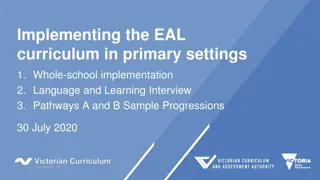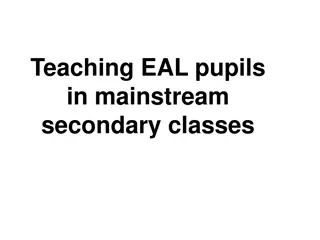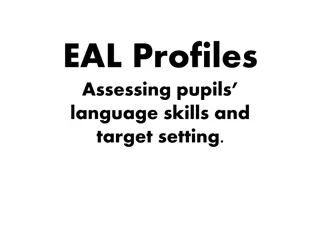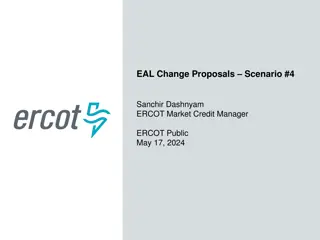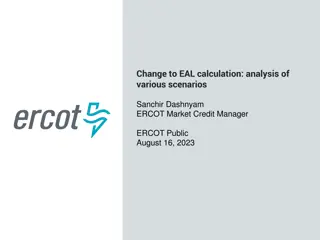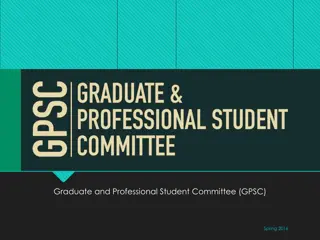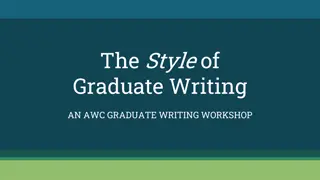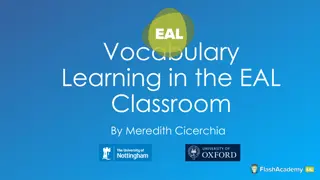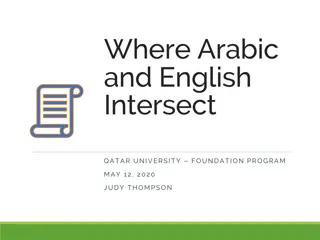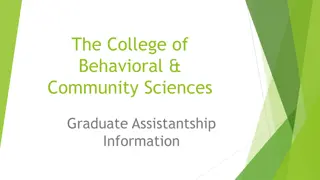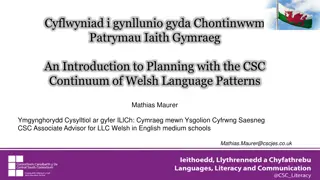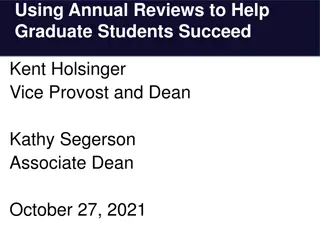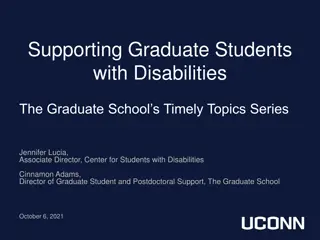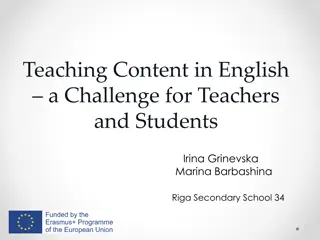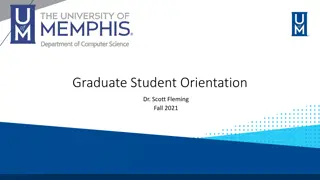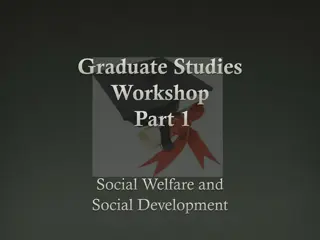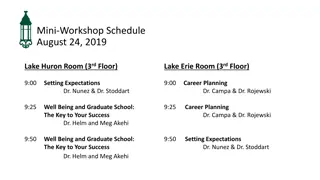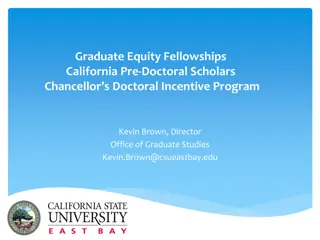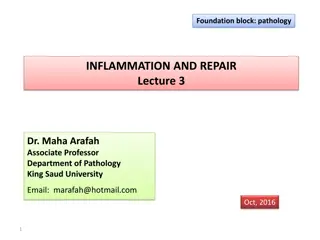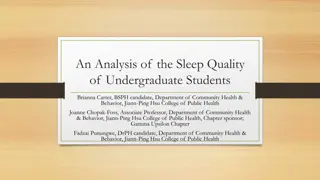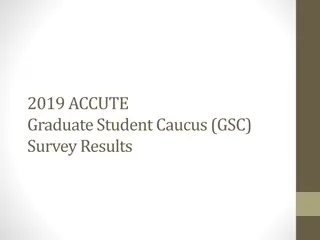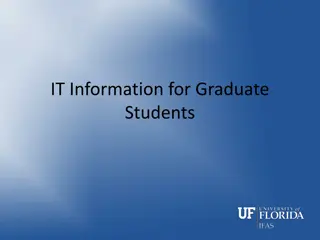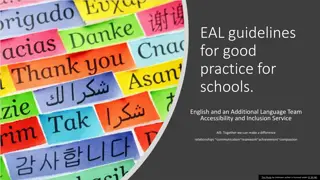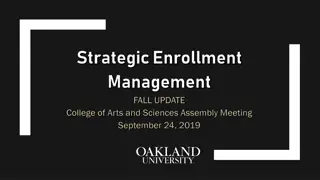Graduate Outcomes of Undergraduate Students with English as an Additional Language (EAL): Patterns and Implications
This research study conducted by Dr. Pamela Humphreys at Macquarie University's English Language Centre focuses on the graduate outcomes of undergraduate students with English as an additional language (EAL). The study explores patterns and implications of these outcomes, analyzing factors such as English language proficiency, gender, first language, discipline, entry pathway to university, and reasons for taking the IELTS test. The methods involve data collection from a single-site Australian university with a sample size of 564 undergraduate EAL students, measuring variables such as GPA and IELTS scores at graduation. The research aims to identify systematic variabilities in graduate outcomes and their correlations with different factors.
Download Presentation

Please find below an Image/Link to download the presentation.
The content on the website is provided AS IS for your information and personal use only. It may not be sold, licensed, or shared on other websites without obtaining consent from the author. Download presentation by click this link. If you encounter any issues during the download, it is possible that the publisher has removed the file from their server.
E N D
Presentation Transcript
Graduate Outcomes of Undergraduate Students with English as an Additional Language (EAL): Patterns and Implications DR PAMELA HUMPHREYS MACQUARIE UNIVERSITY ENGLISH LANGUAGE CENTRE UECA Assessment Symposium 2018
Overview Introduction Methods Results Discussion
Introduction Literature English language proficiency (ELP) in higher education (Arkoudis & Doughney, 2014; Birrell et al., 2006; IEAA, 2013) Exit testing (Craven, 2011; Humphreys & Mousavi, 2010; Knoch, Rouhshad, Oon & Storch, 2015; O Loughlin & Arkoudis, 2009)
Introduction Regulatory environment Principles and standards (AUQA, 2012; DEEWR, 2008; Barthel, 2012) Focus on ELP by national regulators (Australian Government, 2015; Australian Government, 2015)
Introduction: Research Questions RQ 1 What are the graduating outcomes of undergraduate international EAL students (as measured by IELTS (Academic) and GPA)? RQ 2 Is there any systematic variability in these graduating outcomes correlating with the variables of i) gender, ii) first language, iii) discipline, iv) entry pathway to the University, or v) reason for taking the IELTS test?
Methods: Data collection Single site Australian university Undergraduate EALs IELTS (Academic) exit test Voluntary; subsidised Captive sample n = 564
Methods: Data collection ID Date of birth Gender First language Entry pathway Undergraduate degree program Grade Point Average (GPA) at graduation IELTS (Academic) at graduation Reason for taking IELTS test
Methods: Data analysis R Statistical Software version 3.2.1 Descriptive statistics Preliminary data plots Linear regression (Casella & George, 1992; Kaplan, 2014; Madsen & Thyregod, 2011)
Methods: 2 Dependent Variables Variables IELTS (Academic) 0-9 Grade Point Average (GPA) 0-7
Methods: 5 Independent Variables Gender First language Discipline Entry pathway Reason for taking the IELTS test Variables IELTS Academic Grade Point Average (GPA)
Methods: Independent Variables Gender (2) First language (43 aggregated* to 8) Discipline (4) Entry pathway (4) Reason for taking the IELTS test (4) Variables Male English Business Proficiency test Migration IELTS Academic Female Chinese Health Language of Instruction (LOI) Employment Vietnamese Science & Technology Further study Korean Diploma pathway partner (PP) Other Arts & Social Sciences *Indian languages Grade Point Average (GPA) *African languages Direct Entry Program pathway (DEP) *Indo-European languages *Austronesian languages
IELTS Overall Scores (n = 564) Variable n Minimum Maximum Mean Median SD IELTS Overall (0-9) 564 4.0 9.0 6.61 6.5 .85 N.B. Undergraduate entry level at time of data collection was IELTS 6.0
IELTS Overall Scores (n = 564) Variable n Minimum Maximum Mean Median SD IELTS Overall (0-9) 564 4.0 9.0 6.61 6.5 .85 Paired t-test: (M = 6.91, SD = .78), t(86) = 6.34, p < .000 (two-tailed)
Cross-tabulation (n = 86) PRE/POST SCORES Cross tabulation of Pre- and Post- IELTS Scores IELTS Overall post-test scores 6.0 6.5 7.0 9 18 6 6 5 1 3 5 1 10 27 17 Total 5.5 7.5 8.0 8.5 9.0 4 37 18 24 4 3 86 6.0 6.5 7.0 7.5 8.0 IELTS Overall pre-test scores 7 7 1 1 4 1 1 6 3 1 1 5 1 1 5 15 Total ( 2 (28, n = 86) = 87.09, p = .000) Mean increase of .38 of a band score
GPA Scores (n = 564) Variable n Minimum Maximum Mean Median SD GPA (0-7) 564 2.96 6.9 4.67 4.57 .77
Correlation between GPA & IELTS Variable GPA Listening Reading Writing Speaking Overall IELTS GPA 1 .39*** .41*** .32*** .19*** .38*** Note: ***p < .001
Coefficient Mean LCI UCI Intercept 8.14 7.83 8.45 Females 0 Males -0.14 -0.27 -0.02 0 Business English 0 African -0.33 -0.65 0.00 Austronesia -0.78 -1.18 -0.38 Chinese -1.45 -1.72 -1.18 Indian -0.91 -1.20 -0.62 Indo European -0.35 -0.67 -0.03 Korean -1.39 -1.70 -1.10 Vietnamese -1.56 -1.90 -1.20 Social sciences -0.06 -0.29 0.17 Health -0.18 -0.38 0.03 Science/Technology 0.15 -0.04 0.35 TEST 0 DEP -0.57 -0.81 -0.32 LOI -0.18 -0.35 0.00 PP -0.40 -0.57 -0.24 Employment in Australia 0 Further study -0.23 -0.42 -0.06 Migration -0.04 -0.19 0.11 Other 0.03 -0.17 0.23 Sigma 0.65 0.62 0.70
Coefficient Mean LCI UCI Intercept 8.14 7.83 8.45 Females 0 Males -0.14 -0.27 -0.02 0 Business English 0 African -0.33 -0.65 0.00 Austronesia -0.78 -1.18 -0.38 Chinese -1.45 -1.72 -1.18 Indian -0.91 -1.20 -0.62 Indo European -0.35 -0.67 -0.03 Korean -1.39 -1.70 -1.10 Vietnamese -1.56 -1.90 -1.20 Social sciences -0.06 -0.29 0.17 Health -0.18 -0.38 0.03 Science/Technology 0.15 -0.04 0.35 TEST 0 DEP -0.57 -0.81 -0.32 LOI -0.18 -0.35 0.00 PP -0.40 -0.57 -0.24 Employment in Australia 0 Further study -0.23 -0.42 -0.06 Migration -0.04 -0.19 0.11 Other 0.03 -0.17 0.23 Sigma 0.65 0.62 0.70
Coefficient Mean LCI UCI Intercept 8.14 7.83 8.45 Females 0 Males -0.14 -0.27 -0.02 0 Business English 0 African -0.33 -0.65 0.00 Austronesia -0.78 -1.18 -0.38 Chinese -1.45 -1.72 -1.18 Indian -0.91 -1.20 -0.62 Indo European -0.35 -0.67 -0.03 Korean -1.39 -1.70 -1.10 Vietnamese -1.56 -1.90 -1.20 Social sciences -0.06 -0.29 0.17 Health -0.18 -0.38 0.03 Science/Technology 0.15 -0.04 0.35 TEST 0 DEP -0.57 -0.81 -0.32 LOI -0.18 -0.35 0.00 PP -0.40 -0.57 -0.24 Employment in Australia 0 Further study -0.23 -0.42 -0.06 Migration -0.04 -0.19 0.11 Other 0.03 -0.17 0.23 Sigma 0.65 0.62 0.70
Posterior estimates of linear regression for First Language (IELTS) English
Posterior estimates of linear regression for Entry pathway (IELTS) Proficiency test
Coefficient Mean LCI UCI Intercept 8.14 4.80 5.50 Females 0 Males -0.17 -0.31 -0.03 Business 0 African -0.41 -0.78 -0.04 Austronesia -0.17 -0.61 0.29 Chinese -0.27 -0.57 0.03 Indian -0.52 -0.84 -0.19 Indo European 0.05 -0.30 0.42 Korean -0.26 -0.60 0.08 Vietnamese -0.02 -0.42 0.38 0.07 -0.20 0.33 Social sciences Health 0.05 -0.19 0.28 Science/Technology 0.32 0.10 0.53 TEST 0 DEP -0.32 -0.60 -0.04 LOI -0.12 -0.31 0.08 PP -0.22 -0.41 -0.03 Employment in Australia 0 Further study -0.09 -0.29 0.10 Migration -0.11 -0.27 0.06 Other 0.14 -0.08 0.36 English 0 Sigma 0.74 0.70 0.79
Coefficient Mean LCI UCI Intercept 8.14 4.80 5.50 Females 0 Males -0.17 -0.31 -0.03 Business 0 African -0.41 -0.78 -0.04 Austronesia -0.17 -0.61 0.29 Chinese -0.27 -0.57 0.03 Indian -0.52 -0.84 -0.19 Indo European 0.05 -0.30 0.42 Korean -0.26 -0.60 0.08 Vietnamese -0.02 -0.42 0.38 0.07 -0.20 0.33 Social sciences Health 0.05 -0.19 0.28 Science/Technology 0.32 0.10 0.53 TEST 0 DEP -0.32 -0.60 -0.04 LOI -0.12 -0.31 0.08 PP -0.22 -0.41 -0.03 Employment in Australia 0 Further study -0.09 -0.29 0.10 Migration -0.11 -0.27 0.06 Other 0.14 -0.08 0.36 English 0 Sigma 0.74 0.70 0.79
Coefficient Mean LCI UCI Intercept 8.14 4.80 5.50 Females 0 Males -0.17 -0.31 -0.03 Business 0 African -0.41 -0.78 -0.04 Austronesia -0.17 -0.61 0.29 Chinese -0.27 -0.57 0.03 Indian -0.52 -0.84 -0.19 Indo European 0.05 -0.30 0.42 Korean -0.26 -0.60 0.08 Vietnamese -0.02 -0.42 0.38 0.07 -0.20 0.33 Social sciences Health 0.05 -0.19 0.28 Science/Technology 0.32 0.10 0.53 TEST 0 DEP -0.32 -0.60 -0.04 LOI -0.12 -0.31 0.08 PP -0.22 -0.41 -0.03 Employment in Australia 0 Further study -0.09 -0.29 0.10 Migration -0.11 -0.27 0.06 Other 0.14 -0.08 0.36 English 0 Sigma 0.74 0.70 0.79
Posterior estimates of linear regression for First Language (GPA) English
Posterior estimates of linear regression for Entry pathway (GPA) Proficiency test
Research Questions RQ 1 What are the graduating outcomes of undergraduate international EAL students (as measured by IELTS (Academic) and GPA)? RQ 2 Is there any systematic variability in these graduating outcomes correlating with the variables of i) gender, ii) first language, iii) discipline, iv) entry pathway to the University, or v) reason for taking the IELTS test?
Discussion Within the identified variables Limited language improvement during degrees Language is not guaranteed to improve L1 is a legitimate explanation for increased potential linguistic challenges: the greater the distance from English, the greater the challenge The same patterns by L1 were not found for academic outcomes as linguistic outcomes Different linguistic groups require differentiated support Language is a key enabler but not guarantee of academic success Tendencies rather than predictions of future student performance: beware generalisations Is first language an intervening variable masking other aspects of within-group homogeneity (Cummins & Swain, 1984; Phakiti, Hirsh & Woodrow, 2013)?
Agent management Foreign Service Institute typology of language difficulty French Italian Spanish Swedish Czech Russian Turkish Urdu 1 2 Estonian Finnish Thai Vietnamese Arabic Mandarin/Cantonese Korean Japanese 3 4 http://aboutworldlanguages.com/language-difficulty
Discussion Beyond the identified variables
Discussion Beyond the identified variables Individual differences (Cotton & Conrow, 1998; Storch & Hill, 2008; Phakiti, Hirsh & Woodrow, 2013) Cognitive factors (Criper & Davies, 1998) Socioeconomic factors (Bailey & Butler, 2007; Cummins, 2000) Further research needed
Implications for ELICOS providers ELICOS providers play an important role in ensuring strong language proficiency at commencementof higher ed program can message to students about likely limited ELP improvement once commence degree should encourage students to develop skills to continue to develop their ELP
Implications for higher ed providers Higher ed providers should have (and communicate) realistic expectations of ELP improvement explicitly attend to ELP during degrees target academic language support for speakers of first languages more typologically distant from English target academic skills support for speakers of African and Indian languages
References Arkoudis, S., & Doughney, L. (2014). Good practice report English language proficiency. Sydney: Office for Learning and Teaching. Retrieved from http://www.cshe.unimelb.edu.au/research/teaching/docs/GPR_English_language_2014.pdf Australian Government. (2015). Draft national strategy for international education. ISBN: 978-1-74361-889-9. Retrieved from https://internationaleducation.gov.au/International- network/Australia/InternationalStrategy/Documents/Draft%20National%20Strategy%20for%20International%20Education.pdf Bailey, A. L., & Butler, F. A. (2007). A conceptual framework of academic English language for broad application to education. In A. L. Bailey (Ed.), The language demands of school: Putting academic English to the test (pp. 68-102). New Haven: Yale University Press. Barthel, A. (2012). English Language Standards for Higher Education. Retrieved from http://www.aall.org.au/sites/default/files/BarthelCamRev26Jun12_0.pdf Birrell, B., Hawthorne, L., & Richardson, S. (2006). Evaluation of the General Skilled Migration Categories Report. Commonwealth of Australia. Retrieved from http://www.flinders.edu.au/sabs/nils- files/reports/GSM_2006_Full_report.pdf Casella, G. & George, E. (1992). Explaining the Gibbs Sampler. The AmericanStatistician 46(3), 167-174. Cotton, F., & Conrow, F. (1998). An investigation into the predictive validity of IELTS amongst a group of international students studying at the University of Tasmania. IELTS Research Reports, 1, 72-115. Canberra: IELTS Australia Pty Limited. Craven, E. (2012). The quest for IELTS 7.0: Investigating English language proficiency of international students in Australian universities. IELTS Research Reports, 13, 1 61. Criper, C., & Davies, A. (1988). ELTS validation project report. ELTS Research Report 1(i). Cambridge: British Council and University of Cambridge Local Examinations Syndicate. Cummins, J. (2000). Language, Power & Pedagogy: Bilingual Children in the Crossfire. Clevedon, UK: Multilingual Matters. Cummins. J., & Swain, M. (1983). Analysis-by-rhetoric: Reading the text or the reader s own projections? A reply to Edelsky et al. Applied Linguistics, 4(1), 23-41. Department of Education Employment & Work Relations (DEEWR). (2008). Good Practice Principles for English Language Proficiency for International Students in Australian Universities Final Report. Retrieved May 5 2009, from http://www.deewr.gov.au/HigherEducation/Publications/Pages/GoodPracticePrinciples.aspx Humphreys, P., & Mousavi, A. (2010). Exit-testing a whole of university approach, Language Education in Asia, 1(1), 8 22. Retrieved from http://dx.doi.org/10.5746/LEiA/10/V1/A03/Humphreys_Mousavi Humphreys, P. (2015). English Language Proficiency in Higher Education: Student conceptualisations and outcomes. Unpublished doctoral dissertation. Griffith University, Queensland, Australia. International Education Association of Australia (IEAA). (2013). Five years on: English language competence of international students. Outcomes Report, June 2013. Retrieved from http://www.ieaa.org.au/research-projects/english- language-competence Kaplan, D. (2014). Bayesian statistics for the social sciences. New York, NY: Guilford Press. Knoch, U., Rouhshad, A., Oon, S.P., & Storch, N. (2015). What happens to ESL students writing after three years of study at an English medium university? Journal of Second Language Writing, 28, 39-52. Madsen, H., & Thyregod, P. (2011). Introduction to general and generalized linear models. Boca Raton, FL: CRC Press. O Loughlin, K., & Arkoudis, S. (2009). Investigating IELTS exit score gains in higher education. IELTS Research Reports, 10. IELTS Australia Pty Ltd, Canberra Phakiti, A., Hirsh, D., & Woodrow, L. (2013). It s not only English: Effects of other individual factors on English language learning and academic learning of ESL international students in Australia. Journal of Research in International Education, 12(3), 239-258. Storch, N. & Hill, K. (2008). What happens to international students English after one semester at university? Australian Review of Applied Linguistics, 31(1), 04.1 04.17. Tertiary Education Quality and Standards Agency (TEQSA). (2013). Quality assessment: English Language Proficiency Terms of Reference, March 2013. Retrieved from http://www.teqsa.gov.au/sites/default/files/EnglishLanguageProficiencyQATerms.pdf
